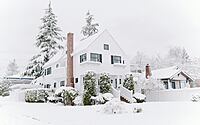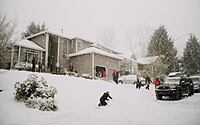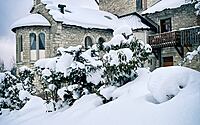Winter Challenges in Industrial Facilities: Effective Snow Removal Solutions
Winter poses unique challenges for industrial facilities, where snow and ice accumulation can disrupt operations, compromise safety, and lead to costly downtime. As the cold season approaches, it becomes imperative for industrial facility managers to have effective snow removal solutions in place, including salt suppliers services.
In this article, we will explore the winter challenges faced by industrial facilities and delve into proven strategies and solutions for efficient snow removal, ensuring that businesses can operate smoothly even in the harshest of winter conditions.
1. Snow Accumulation on Roofs
One of the significant challenges that industrial facilities face during winter is the accumulation of snow on roofs. Heavy snow loads can pose a serious threat to the structural integrity of buildings, potentially leading to roof collapses or damage. To mitigate this risk, facility managers must regularly inspect roofs for snow buildup and employ proper snow removal techniques when necessary. Snow rakes, snow blowers, and professional snow removal services can be instrumental in safely removing snow from roofs, ensuring the safety of the facility and its occupants.
Solution: Regular Snow Removal
To address the challenge of snow accumulation on roofs, especially in light of the Wisconsin winter forecast, industrial facilities should implement regular snow removal plans. This involves using specialized equipment like snow rakes or snow blowers to safely remove excess snow from the roof. Additionally, proactive monitoring and scheduling of snow removal services can help prevent overloading and potential structural damage, ensuring the safety and integrity of your facility during the winter months.
2. Accessible Walkways and Emergency Exits
Maintaining accessible walkways and clear emergency exits is critical for industrial facilities during the winter months. Accumulated snow and ice on walkways and around exits can impede safe evacuation in case of emergencies. Facility managers must prioritize snow removal and de-icing efforts in these areas to ensure that employees can navigate the facility safely. This includes salting or sanding walkways, installing anti-slip mats, and promptly clearing snow and ice from exits.
Solution: Priority Snow Clearance
Facilities should prioritize the clearing of walkways and emergency exits during winter. This includes using de-icing agents, such as salt or sand, to prevent ice formation and promptly clearing snow from these areas after each snowfall. Installing anti-slip mats near entrances and exits can further enhance safety.
3. Snow-Covered Parking Lots and Loading Docks
Snow-covered parking lots and loading docks can disrupt operations and pose safety risks. Industrial facilities rely on the timely arrival of goods and employees, and snow accumulation can hinder these processes. Effective snow removal plans for parking lots and loading docks are essential to maintaining productivity and safety. Employing plows, loaders, and de-icing strategies can help keep these areas clear and functional.
Solution: Timely Snow Removal
To maintain operational efficiency, industrial facilities should establish a snow removal plan for parking lots and loading docks. This involves employing snow plows, loaders, or snow blowers to keep these areas clear and accessible. Regularly monitoring weather forecasts and initiating snow removal operations before heavy snowfall can prevent disruptions.
4. Snow Removal Equipment Maintenance
Industrial facilities often have a range of snow removal equipment, such as plows, snow blowers, and salt spreaders. Ensuring that this equipment is well-maintained and in proper working condition is crucial for efficient snow removal operations. Regular inspections, repairs, and maintenance checks before the winter season can prevent equipment breakdowns and downtime during critical snow removal efforts.
Solution: Routine Inspection and Maintenance
Proper maintenance of snow removal equipment is essential. Facilities should conduct routine inspections, servicing, and repairs before the winter season begins. This ensures that snow plows, snow blowers, and other equipment are in good working condition and ready to tackle snow removal tasks efficiently.
5. Employee Safety and Productivity
Employee safety and productivity are paramount concerns during winter in industrial facilities. Slip and fall accidents due to icy conditions can result in injuries and lost work hours. Facilities should invest in employee safety training, provide appropriate winter gear, and maintain clear communication regarding safety protocols during winter weather conditions. By prioritizing employee safety, facilities can minimize accidents and maintain productivity levels.
Solution: Safety Training and Equipment
To address employee safety and productivity concerns, facilities should invest in comprehensive safety training programs for employees. This training should cover winter weather hazards, safe walking and working practices, and the use of appropriate winter gear. Encouraging open communication about safety concerns and implementing clear safety protocols during winter conditions is vital.
6. Compliance with Regulations
Industrial facilities are often subject to various regulations and standards regarding safety and snow removal. Compliance with these regulations is not only essential for avoiding legal issues but also for maintaining a safe and efficient workplace. Facility managers should be aware of relevant regulations, such as OSHA guidelines for safe walking and working surfaces, and ensure that their snow removal practices align with these requirements. Regular audits and assessments can help identify areas where compliance can be improved.
Solution: Regulatory Awareness and Adherence
Facility managers should stay informed about relevant regulations and standards related to snow removal and winter safety, such as those outlined by OSHA. Implementing practices that align with these regulations, conducting regular compliance assessments, and making necessary adjustments ensure that the facility remains compliant with legal requirements and fosters a safe working environment.
Conclusion
Managing winter challenges in industrial facilities demands effective snow removal solutions to ensure safety and productivity. One critical aspect to consider is “how much does snow removal service cost?” While the cost may vary depending on factors like facility size, location, and the extent of snowfall, it’s essential for facility managers to budget adequately for professional snow removal services.
On average, the cost of commercial snow removal services can range from $75 to $200 per visit, depending on the mentioned variables. By investing in reliable snow removal services, industrial facilities can minimize downtime, maintain operational efficiency, and ensure a safe working environment during the winter months.
- by Matt Watts




